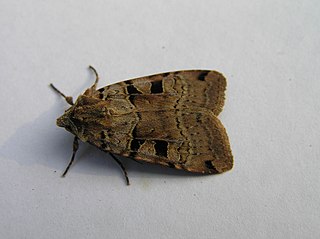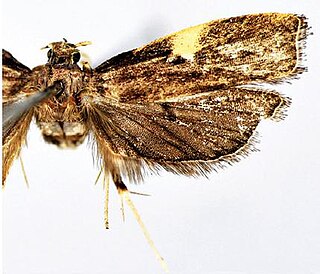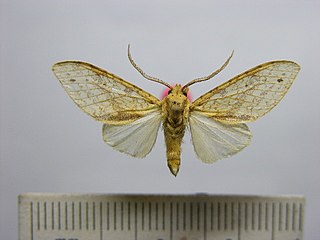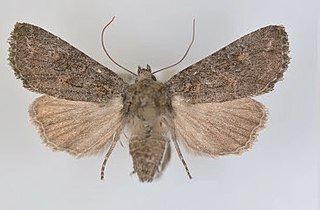
The double square-spot is a moth of the family Noctuidae. It is distributed through most of Europe except Portugal, the Mediterranean islands and northernmost Fennoscandia. In the East, the species ranges East across the Palearctic to Siberia and in the South-East to the Black Sea and in Iran. It rises to a height of about 2,000 metres (6,600 ft) in the Alps.

Syssphinx bicolor, the honey locust moth, is a North American moth in the family Saturniidae.
Licigena is a monotypic genus of moths belonging to the subfamily Olethreutinae of the family Tortricidae. Its sole species is Licigena sertula, which has been found in Sri Lanka. Both the genus and species were first described by Alexey Diakonoff in 1982.

Thubana felinaurita is a species of moth of the family Lecithoceridae. It is found in Guangxi in China.
Ethmia scylla is a moth in the family Depressariidae. It is in California, United States.
Ethmia papiella is a moth in the family Depressariidae. It is found in the Sinaloan thorn forest on the west coast of Mexico.
Ethmia iridella is a moth in the family Depressariidae. It is found in Mexico.

Ethmia elutella is a moth in the family Depressariidae. It is found from Panama to Venezuela and Trinidad. There is also a record from Chile.

Ethmia janzeni is a moth in the family Depressariidae. It is found from Mexico to San Salvador, as well as in north-western Costa Rica. The habitat consists of dry forests and rain forests.
Ethmia cupreonivella is a moth in the family Depressariidae. It is found in Brazil.
Ethmia phylacops is a moth in the family Depressariidae. It is found in Mexico.
Ethmia confusella is a moth in the family Depressariidae. It is found from the Florida Keys and Bahamas, through the Greater Antilles to the Yucatan Peninsula, and through the Lesser Antilles to Trinidad.
Ethmia confusellastra is a moth in the family Depressariidae. It is found on the Yucatan Peninsula and Cuba.
Ethmia subnigritaenia is a moth in the family Depressariidae. It is found in Mexico.
Ethmia howdeni is a moth in the family Depressariidae. It is native to Mexico and Central America.
Ethmia albicostella is a moth in the family Depressariidae. It is a widespread species in the Rocky Mountains and Sierra Madre Occidental of Mexico, ranging from southern Manitoba, Saskatchewan, and Montana through the southern Rocky Mountain states at moderately high elevations and mountains of western Mexico at least south to Durango.
Ethmia mirusella is a moth in the family Depressariidae. It is found in the United States from Kansas and Oklahoma to central and western Texas.

Ethmia linda is a moth in the family Depressariidae. It is found from Venezuela to southern Mexico.

Lophocampa debilis is a moth of the family Erebidae. It was described by William Schaus in 1920. It is found in Mexico, Costa Rica and Guatemala.

Aseptis perfumosa is a moth of the family Noctuidae first described by George Hampson in 1918. It is endemic to southern California, where it occurs in many habitats such as coastal chaparral and canyons, urban areas, brush land, and open oak forest from sea level to 2000 meters.







